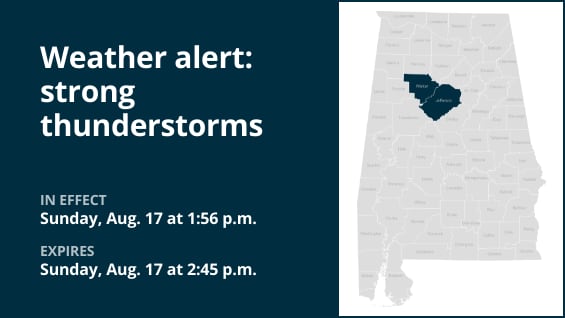At 1:56 p.m. on Sunday, the National Weather Service issued a weather notice for Walker and Jefferson counties, warning of heavy thunderstorms through 2:45 p.m.
Pea-sized hail (0.25 inches) and wind gusts of up to 40 mph are predicted to accompany the storms.
“At 1:56 p.m., Doppler radar tracked a strong thunderstorm over Gorgas Steam Plant, or 9 miles southwest of Dora, moving south at 15 mph,” according to the meteorological service. Gusty winds have the potential to blow around unsecured objects and topple tree branches. There is a chance of minor hail damage to vegetation.
Gorgas Steam Plant, Gorgas, Tutwiler, Goodsprings, Birmingport, and Little Shoal are among the locations affected by the alert.
Additionally, the weather service advises, “If outdoors, consider seeking shelter inside a building.”
Preparing for approaching lightning: Expert safety advice
About 25 million lightning strikes occur in the US annually, primarily in the summer. The weather service estimates that it kills around 20 people a year. As thunderstorms get closer, the risk of lightning increases; it peaks when the storm is directly overhead and then progressively decreases as it passes.
Consider the following advice to keep yourself safe during a thunderstorm:
Plan for lightning safety:
-
When venturing outdoors, it’s crucial to have a lightning safety plan in place.
-
Stay vigilant by monitoring the sky for ominous signs and listening for the telltale sound of thunder. If thunder is audible, it’s a clear indication of nearby lightning.
-
Seek shelter promptly in a safe location, preferably indoors.
Indoor safety precautions:
-
Once you’re indoors, avoid using corded phones, electrical devices, plumbing fixtures, and stay away from windows and doors.
-
Lightning can follow conductive pathways, and these precautions reduce the risk of electrical surges.
Hold off till the all-clear:
-
After the last lightning strike or thunderclap, wait at least 30 minutes before resuming outdoor activities.
-
Lightning can strike even when a storm has seemingly passed, so exercise caution.
When there is no indoor shelter:
Take these precautions to increase your safety if you are outside during a thunderstorm without access to indoor shelter:
-
Avoid open fields, hilltops, or ridge crests, which expose you to greater lightning risk.
-
Steer clear of tall, isolated trees and other prominent objects. In forested areas, stay close to lower stands of trees.
-
If you’re in a group, ensure that individuals are spaced out to prevent lightning current from transferring between people.
-
Camping in an open setting during a thunderstorm is strongly discouraged. If you have no alternative, set up camp in a valley, ravine, or other low-lying areas. It’s crucial to note that a tent provides no protection against lightning.
-
Do not approach water bodies, wet objects, or metal items. While water and metal don’t attract lightning, they conduct electricity effectively and can pose significant risks.
In conclusion, being alert and ready are your best defenses against lightning threats. You may put your safety first and drastically lower the likelihood of lightning-related mishaps by adhering to these rules.
Mastering wet roads: Safety tips for heavy rainfall
If heavy rainfall persists or if runoff is substantial, flooding may result. Saturated soils and/or heavy rainfall can cause excessive runoff. To keep safe during periods of intense rain, heed these weather service recommendations:
Watch out for flooding rivers:
Avoid parking or strolling close to culverts or drainage ditches during periods of intense precipitation, as the swift-moving water can be quite dangerous.
Keep your distances from other vehicles safe:
In heavy rain, the two-second rule of following distance is your friend. To guarantee safe spacing under unfavorable circumstances, increase it to four seconds.
Reduce your speed and exercise caution:
Reduce your speed if it’s raining and the roads are wet. Reduce your speed gently by taking your foot off the accelerator. Never apply the brakes abruptly since this could cause the vehicle to slide.
Pick your lane carefully:
Water tends to pool in the outside lanes, so stick to the central ones.
Visibility is important.
Turn on your headlights to improve visibility in severe rain. Rain-stained windows can hide cars in blind situations, so be cautious.
Be cautious on slick roads:
Because of a combination of rain, oil, and grime, roadways are at their slickest during the first 30 minutes of precipitation. Be especially careful during this time.
Stay a safe distance away from big cars:
Tire spray from big vehicles and buses can make it harder to see. Be careful when passing and refrain from tailgating.
Be mindful of your wipers:
The wiper blades may be overloaded by heavy rain. It’s time to stop and wait for the rain to stop when visibility is so poor that you can’t see other cars or the road’s borders from a safe distance. Stopping at rest areas or other sheltered spaces is the best option.
Position your car as far off the road as you can, preferably beyond guardrails, if stopping by the side of the road is your only choice. To let other cars know where you are, turn on your emergency flashers and keep your headlights on.
Taking these safety measures will significantly improve your road safety while it’s raining a lot. For a safe trip, keep yourself updated on weather conditions and follow local authorities’ instructions.
United Robots offers a service called Advance Local Weather Alerts that gathers the most recent information from the National Weather Service using machine learning.






